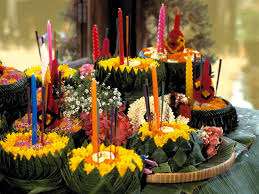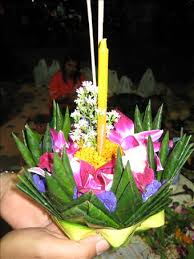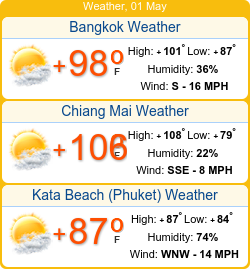
What's Happening at Wat Tampa
Search
Wat Tampa Visitors
GenericHolidays
Saturday ceremony on Saturday November 16, 2024
This is one of the most beautiful and popular festivals in Thailand. Loy Krathong is celebrated on the day of the full moon in November. Part of the reason for its popularity is the weather, which is quite pleasant. The temperature is mild, the monsoon rains have subsided, and there is plentiful water in the klongs (canals).
The central event in Loy Krathong is the launching of krathongs. A krathong is a small lotus-shaped vessel made of banana leaves, flowers, candles, and three incense sticks. Don't be confused by this simple description. Many krathongs are elaborate vessels that take many hours to construct. People launch the krathongs into any "large" body of water to carry away their bad luck. Prior to launching they light the candle and incense and make a wish. It is considered good luck if the krathong floats away from you.


Loy Krathong originated about 700 years ago in the Sukhothai kingdom. Sukhothai is located about half way between Bangkok and Chiang Mai in the north of Thailand. The farmers during this period of Thai history held a festival to launch floating candles to thank the water god for the waters. This ceremony coincided with the end of the harvest season. A beautiful woman named Noppamas made the first decorated krathong using banana leaves in the shape of a lotus flower. King Lithai saw the decorated float and decreed that krathongs would be floated every year.
At Wat Tampa our festival will feature, of course, launching Krathongs into the Palm River. many other activities are planned and will be listed here once the planning for this years festival is completed. As part of the Loy Krathong Festival we usually hold the "Nopamas Queen" beauty contest.
Activities will include:
- Ms. Noppamas Pageant
- Lotus floating to honor "Phra Mae Khongha", the Thai Goddess of Water
- Traditional Thai Dancing
- Local Thai band "Song Funghong"
- Delicious authentic Thai food
The following is a list of items that are celebrated in Thailand. Enjoy!
1. To pay respect to the footprint of Buddha found on the bank of Nammathanayi, one of the rivers in the regionof Thakkhinabot, India, which is known as Nehrabhuddha River today.
2. To pay respect to and seek forgiveness from Phra Mae Khongkha, the Water Goddess, for past misdeeds. It's also a chance to express our gratitude to the river since it provides us with water to use and drink.
3. To worship Phra Upakut, which is highly venerated by worshippers in Northen Thailand. According to legend, after achieving nirvanna Phra Upakut went to practice meditation under the deep sea.
4. Floating a krathong is believed to dispel bad luck as well as bring fortune. (editors note: Assumes the krathong floats away from you).
5. Putting some coins in a krathong is believed to bring you wealth in the coming year.
6. Loy Krathong promotes family bonding. It is a chance for us to spend time with family, friends, and loved ones.
7. Loy Krathong promotes economy within the community, society, and nation at large.
8. Putting nail and hair clippingsin a krathong is believed to ward off bad luck.
9. Loy Krathong promotes handcraftsmanship, creativity, and folk wisdom by encouraging the use of natural materials.
10. To carry on the beautiful Thai traditionthat has been passed on down to us from Sukhothai Kingdom (mid-13th century to late 14th century).
Click here to see information on the Loy Krathong Festival in Bangkok.
The first day of Thai Lent is referred to as Asalha Puja Day (or Commencement Day). This holiday will be celebrated at Wat Tampa on July 14 this year. The date of all of the Thai festivals is based on the lunar calendar so the "American" dates vary from year to year. You may also here Lent referred to as the "rains retreat."
Since the beginning of Thai Lent we celebrate Thai Mothers Day and Sart Thai Day (also known as Memorial day. Thai Mothers day pays respect to all Thai mothers and, in particular, the Queen of Thailand. Sart Thai Day is a celebration of the beginning of the harvest and is an opportunity to thank the deities for a successful harvest.
The end of Lent is marked by Ok Phansa. Ok Phansa marks the end of the "rains retreat" and the beginning of Krathin. Monks can return to their social duties and travel. Ok Phansa is also celebrated by lay people offering food and gifts to the monks. Ok Phansa is celebrated throughout Thailand but the celebrations vary by region.
According to legend Ok Phansa also celebrates the Buddha‘s return to earth, after spending one Lent season, which is 3 month long, preaching in heaven. It also marks the end of the Lent period of retreat and the beginning of Krathin, the traditional time for presenting new robes and other gifts to monks at temples throughout the country. This ceremony must be completed within one month of the end of Buddhist lent and only one ceremony in a year.
The Kathina ceremony may be held in conjunction with the End of Buddhist Lent celebration. The history behind the kathina Ceremony is as follows:
During Lent (roughly the rainy season in Thailand) monks could not travel.The monks stayed overnight in the same temple for three lunar months. The Kathina ceremony originates from the time of Buddha. The original ceremony was for a group of monks traveling to meet Lord Buddha. They were unable to completed their journey before the beginning of the rains retreat (Lent). At the end of Lent they completed their journey. Their clothes had become soaked and dirty on their way to meet Lord Buddha. When Buddha saw their condition he allowed lay people to offer the monks yellow robes. The tradition of presenting robes to monks continues today in the Kathina ceremony.
From a historical perspective the word Krathina has four meaning associated with it.
- A wooden frame used as a tool to stretch out a piece of cloth before sewing a new robe
- Any piece of cloth offered to the monks to make new robes with the tool described above
- The name of the merit making ceremony. This ceremony occurs once a year and is considered a day to gain great merit. Robes are presented to monks in general, not to one particular monk.
- The name of the Buddhist ritual.
You may have heard references to the Royal Krathina ceremony. There are, in fact two types of Krathina ceremonies as described below:
- Krathina Luang (Royal Kathina) - these ceremonies at held at royal temples (which includes Wat Tampa).
- Krathina Rart (Krathina Ratsdorn) - these are Kathina ceremonies held by lay people at public Temples The Temple will celebrate the Katrina Ceremony on October 27, 2019.
The word Sart, derived from the Pali language, means season and in particular autumn or fall. Sart Thai day is also referred to as Memorial Day. This is not Memorial Day as Americans might assume. In Thailand, Sart Thai is a time to remember dead relatives with prayers, Buddhist rituals, and merit making on their behalf.
In addition, September crops (including rice) in Thailand are beginning to ripen. As such it marks the start of the harvest (not the end). From a traditional point of view people believed that the first harvest of crops should be offered to the spirits. This was thought to ensure that the harvest would be bountiful and they would avoid starvation.
One of the traditions is the preparation of a sweet dessert called "Krayasart" or "food for the Sart rite". This dessert consists of rice, beans, peanuts, coconut, sesame, and sugar. Lay people would bring "Krayasart" to the Temple to offer to the monks. After the offering, water was poured in dedication to dead ancestors in order to earn merit for them. People believed that the offering of "Krayasart" would mean that their ancestors would have food to eat and that the person would be blessed.
Asalha Puja Day is one of the most sacred days in Buddhism. It is observed on the fifteenth day of the waxing moon of the eight lunar month (July).
Asalha Puja Day is the anniversary of the day on which Lord Buddha delivered his first Sermon to his five Disciples at the Deer Park in Benares, over two thousand five hundred years ago. The day also marks the beginning of the worship of the Triple Gems, namely: the Lord Buddha, His Teachings and His Disciples. This day also is celebrated as Thai Father's day (King's birthday).
The Buddhist Lent starts on the first day of the waning moon of the eighth lunar month. The tradition of Buddhist Lent or the annual three-month Rains Retreat, known in Thai as "PHUN SAA", dates back to the time of early Buddhism in ancient India. All holy men, mendicants and sages spent three months of the annual rainy season in permanent dwellings. They avoided unnecessary travel during this period when crops were still new for fear they might accidentally step on young plants. In deference to popular opinion, Lord Buddha decreed that his followers should also abide by this ancient tradition, and they began to gather in-groups of simple dwellings.
The typical activites for Asalha Puja Day include:
- Monks will recite the Eight Precepts.
- Congregation will give alms to the monks.
- A monk will give a Sermon and lead a Meditation.
- Monks will chant in Sanskrit and lead the lit candle procession three times around the Temple.


